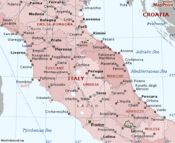By Sasha Smith, NYC Correspondent

So it came to me on Tuesday night as I was chewing on a
mouthful of Vino Nobile di Montepulciano and trying to decide if I could call
the tannins both “firm” and “drying”: the Diploma is to wine what dressage is
to horseback riding – arcane, academic and interesting to an extremely small,
and extremely passionate, group of people.
This point is not lost on Mary Ewing Mulligan,
(from now on, MEM for short) who reminded us that we are “operating in some
never-never land” at arm’s length from the average drinker’s experience. I appreciate
the discipline and critical distance, of course – otherwise I wouldn’t be in
the class – but it borders on the obsessive. At some point, can’t we just drink
the wine and shut up about it?
That being said, this week was one of our best lectures yet. Central Italy,
particularly Tuscany, is clearly near and dear to MEM’s heart. This is a woman
who has spent a lot of time in Chianti, and has a lot to say about it. I
particularly liked the observation she shared about Brunello di Montalcino, which
she picked up from a Tuscan wine merchant: with the best ones, you can feel the
tannins consistently from start to finish as you taste the wine – not just at
the back of the mouth. (I’m not sure how this works, physiologically, as I
think the sensors for tannins are near the middle/back of your mouth, but I’ll
take her word on it). Chianti and Sangiovese-based wines in general don’t rank
among my top ten, or even top twenty, reds, but Mary’s enthusiasm and knowledge
made me wonder if I need to re-evaluate my rankings.
Unfortunately, the wines we tasted kinda sucked. The Verdicchio was either
oxidized and/or over the hill. The Vino Nobile of the firm and drying tannins
was a 2003 and had some unappealing overcooked fruit aromas going on. Ditto for
the Montepulciano d’Abruzzo of the same year. We had a Brunello that Mary liked
quite a bit – a 2001 La Fornace – and that I recognized as a good wine, but didn’t
fall in love with. (Although I
did get the tannin from start-to-finish thing.) Which brings me to another tricky
part of the class: leaving your subjectivity at home. If a Pinotage shows up in
the tasting exam, I’ll have to put aside my intense dislike of the grape and
assess it on its own terms. And vice-versa for Rioja, a wine that I might evaluate too generously
because I like it so much.
My final discovery of the week is that my current study
method, filling out mega Excel spreadsheets on every region, is worthless. I
tried to use some of them to study for our first practice exam question, “Explain
the diversity in Burgundy’s white wines, when there is only one key grape variety” and they’ve been incredibly unhelpful.
Instead I’ve had to reread everything on white Burgundy in Jancis (we’re now on
a
first name basis.)
I have to email my essay off by tomorrow to an anonymous
grader in the UK who will then rip it apart and send it back with all kinds of merciless
comments, or at least that’s what I’ve been told. If they’re anything like the
exam graders, I’m in for a treat. As I wrote in my first post, WSET makes old
exams available, along with comments from the examiners. Here’s one of my
favorites:
“This [tasting note] is a classic example of someone who is seriously
underperforming in this examination. Whilst this candidate is clearly not
English speaking, it was not their lack of fluency that was the problem (in
tasting questions we are looking for accuracy rather than literary skills), it is their failure to use the Systematic
Approach to Tasting. This has resulted in vague, imprecise tasting notes with limited
potential for awarding marks.”
Or how about this classic:
“Questions on Eastern Europe are seldom popular, but quite often those who do attempt
them do well because it is their area of expertise. Sadly this was not the case
here with no candidates achieving distinction and only two with merit. This
question clearly divided those who knew about these regions and those who knew a
few basic facts about a couple of wines. In the case of the latter, many
scripts covered barely half a
side of A4 paper. This is seriously inadequate for this level of
qualification.”
I’m picturing the examiners as a combination between John Houseman in The Paper
Chase and the panel of judges at the end of Flashdance.
What a feeling, indeed.
